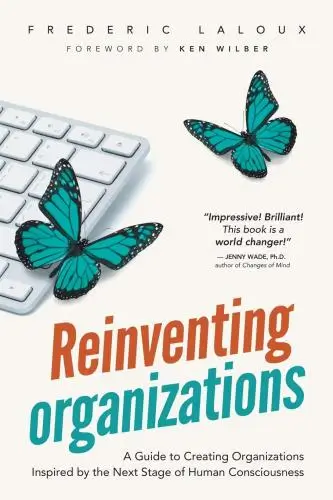Reinventing Organizations
A Guide to Creating Organizations Inspired by the Next Stage in Human Consciousness
What's it about?
Reinventing Organizations is a exploration of how companies can evolve beyond conventional management strategies into next-generation workplaces. Laloux presents a compelling case for adopting more soulful and purposeful practices that empower employees and foster environments of creativity and innovation. Through real-world examples, the book outlines a model for organizations to transition into more holistic and human-centric entities, promising greater fulfillment for employees and superior outcomes for businesses. A must-read for leaders aiming to navigate the future of work.
About the Author
Frederic Laloux is a thought leader in organizational development, celebrated for his groundbreaking book "Reinventing Organizations." With a compelling narrative style, Laloux explores the evolution of human collaboration, presenting a visionary model of work environments that prioritize empowerment and purpose. His unique perspective challenges conventional management wisdom, advocating for soulful workplaces that unlock creativity and potential.
10 Key Ideas of Reinventing Organizations
Embrace Wholeness and Foster an Environment of Trust
Encourage employees to bring their whole selves to work, including their personal passions, emotions, and life experiences.
This approach fosters a culture of trust, openness, and authenticity.
By creating an environment where people feel safe to express themselves fully, organizations can unlock creativity, improve employee satisfaction, and enhance collaboration.
Trust is the foundation of high-performing teams, and when team members feel genuinely supported and valued for who they are, they are more likely to contribute their best work and collaborate effectively.
Learn DeeperCreate a 'safe space' for sharing: Start meetings with a check-in round, allowing each person to share how they're feeling or what's on their mind. This practice can help team members feel heard and valued beyond their professional roles.
Encourage personal development: Offer resources or time for employees to pursue passions or personal projects that may not be directly related to their job. This shows that you value their growth as individuals, not just as workers.
Implement regular feedback loops: Encourage open and honest feedback in both directions - from leadership to employees and vice versa. Make it clear that feedback is a gift meant to foster growth and improvement, not criticism.
Celebrate the whole person: Recognize and celebrate milestones and achievements in your employees' personal lives, such as hobbies, family events, or personal accomplishments. This can help build a more connected and supportive team environment.
- Example
A tech company implements 'Feel Good Fridays' where the first hour of the day is dedicated to an activity unrelated to work, such as yoga, art, or music, led by an employee who is passionate about the topic. This not only allows employees to share a part of themselves but also encourages relaxation and creativity.
- Example
A marketing firm has 'Life Story Lunches' where once a month, a team member shares their life story, challenges they've overcome, and lessons learned along the way. This practice fosters deeper connections among team members and a greater appreciation for the diversity of experiences within the team.
Implement Self-Management Structures
Shift from traditional hierarchical structures to self-management models where decision-making is decentralized.
In self-managing organizations, employees have the autonomy to make decisions related to their work without needing approval from a supervisor.
This empowers individuals and teams, accelerates decision-making processes, and reduces bureaucratic overhead.
Self-management encourages accountability and ownership, as employees have direct influence over their work environment and outcomes.
It also promotes agility, enabling the organization to adapt more quickly to changes in the market or industry.
Learn DeeperStart Small: Begin by implementing self-management practices in a small team or project. This allows everyone to get accustomed to the new way of working without overwhelming them. For instance, let the team make decisions on how to allocate their time and resources.
Encourage Open Communication: Foster an environment where team members feel comfortable sharing their thoughts, ideas, and concerns. Regularly scheduled meetings where everyone can speak freely and openly can help in this regard.
Provide Clear Guidelines: While autonomy is key, providing clear guidelines on decision-making boundaries and responsibilities helps prevent confusion. Outline what decisions team members can make on their own and which ones should be discussed with the broader team.
Offer Support and Training: Transitioning to a self-managed structure can be challenging. Offer training sessions on decision-making, conflict resolution, and effective communication to equip your team with the necessary skills.
Celebrate Successes and Learn from Failures: Recognize and celebrate when decisions lead to positive outcomes. Equally important, view failures as learning opportunities rather than setbacks. This encourages a culture of continuous improvement.
- Example
A software development company allows its teams to decide which projects they want to work on based on their interests and expertise. The teams also set their own deadlines and manage their workload accordingly.
- Example
A retail store empowers its employees to handle customer complaints directly, without needing to escalate to a manager. Employees are trained on conflict resolution and given guidelines on what compensations they can offer to dissatisfied customers.
Cultivate an Evolutionary Purpose
Treat the organization's purpose as something that evolves over time, rather than a static goal.
Encourage continuous listening and responsiveness to the changing needs of stakeholders, including employees, customers, and the broader community.
By aligning organizational activities with a purpose that adapts to serve the greater good, companies can stay relevant and create long-term value.
An evolutionary purpose inspires innovation and engagement, as employees feel they are contributing to meaningful work that makes a difference beyond financial success.
Learn DeeperListen Actively to Stakeholders: Regularly schedule sessions to gather feedback from employees, customers, and community members. Use surveys, focus groups, or open forums to understand their evolving needs and expectations.
Adapt and Innovate Based on Feedback: Once you've gathered insights, brainstorm with your team on how to adapt your products, services, or internal processes. Encourage a culture where innovative ideas aimed at aligning with the evolutionary purpose are recognized and rewarded.
Communicate Changes and Purpose Evolution: Keep all stakeholders informed about how the organization's purpose is evolving and what changes are being made. Transparency builds trust and ensures everyone understands the direction and why changes are happening.
Review and Reflect Regularly: Set aside time for regular reviews of your organizational purpose and the strategies you've implemented to stay aligned with it. This could be quarterly or bi-annually. Adjust as necessary to ensure continued relevance and alignment with the greater good.
- Example
A tech company initially focused on creating educational software for schools realizes through feedback that there's a significant need for adult education in digital literacy. They adapt their purpose to include developing solutions for adult learners, thereby expanding their impact and market.
- Example
A local grocery chain learns from customer and employee feedback that there's a growing demand for locally sourced and sustainable products. They shift their purchasing policies to prioritize local suppliers and implement sustainable practices in their operations, aligning their business with the community's values and environmental sustainability.
Promote Radical Transparency
Share information openly across the organization to build trust, foster inclusivity, and encourage informed decision-making.
Radical transparency involves making financial data, strategic decisions, and even salary information accessible to all employees.
This transparency demystifies aspects of the business that are often kept behind closed doors, empowering employees with the knowledge they need to understand the bigger picture and contribute ideas.
It also helps to prevent misinformation and rumors, creating a more cohesive and aligned workforce.
Learn DeeperStart with Financial Transparency: Begin by sharing key financial metrics with your team. This could include revenue, profit margins, and major expenses. Use regular meetings or a shared dashboard to keep everyone updated.
Implement an Open-Door Policy for Strategic Decisions: Encourage leaders and managers to discuss upcoming strategic decisions openly with their teams. This could involve roundtable discussions or Q&A sessions where employees can ask questions and provide input.
Share Salary Ranges and Criteria for Raises/Promotions: Make the company's salary ranges public within the organization, and clearly outline what criteria are used for raises and promotions. This helps in setting clear expectations and reducing speculation.
Create a Shared Knowledge Base: Develop a centralized location (like an intranet) where all employees can access important documents, project updates, and company news. Regularly update this space to ensure it remains a valuable resource.
Encourage Feedback and Questions: Foster an environment where employees feel comfortable asking questions and providing feedback about the company’s operations. This could be through anonymous surveys, suggestion boxes, or regular feedback sessions.
- Example
A tech startup implements a monthly 'All-Hands Meeting' where the CEO shares the latest financial performance, upcoming product launches, and strategic decisions. Employees are encouraged to ask questions and provide feedback directly.
- Example
A marketing agency creates an internal wiki that includes detailed project timelines, client feedback, and campaign results. This allows team members across different departments to stay informed and contribute ideas based on a comprehensive understanding of the agency's work.
Encourage Peer Relationships and Feedback
Replace traditional performance evaluations with peer-based feedback systems.
Encouraging employees to give and receive constructive feedback among peers fosters a culture of continuous improvement, learning, and development.
Peer relationships are strengthened through mutual support and accountability, leading to a more collaborative and innovative work environment.
This approach decentralizes the evaluation process, making it more democratic and reflective of an individual’s contributions from multiple perspectives.
Learn DeeperStart a Peer Feedback Initiative: Begin by organizing small, informal sessions where team members can share feedback with each other. Focus on creating a safe space where everyone feels comfortable to speak openly and honestly.
Implement Regular Peer Check-Ins: Schedule regular check-ins or 'retrospectives' where peers can discuss what went well, what didn’t, and how they can support each other moving forward. This encourages ongoing dialogue and fosters a culture of continuous improvement.
Create a Peer Recognition Program: Develop a system where employees can recognize their peers for their contributions and achievements. This could be as simple as a shout-out during team meetings or a more formal recognition program.
Encourage Cross-Functional Team Projects: Promote opportunities for employees from different departments to work together on projects. This not only helps in building peer relationships across the organization but also encourages innovation through diverse perspectives.
Offer Training on Constructive Feedback: Provide resources or workshops on how to give and receive feedback constructively. Educating your team on effective communication techniques will enhance the quality of peer feedback.
- Example
At a software development company, the engineering team adopts a bi-weekly retrospective meeting where each member shares one piece of constructive feedback for another team member, focusing on specific actions rather than personal traits. This practice helps identify areas for improvement and strengthens team cohesion.
- Example
A marketing agency introduces a 'Kudos Board' where employees can post notes of appreciation for their peers’ hard work and achievements. This board becomes a source of positive reinforcement and encourages a supportive work environment.
Deeper knowledge. Personal growth. Unlocked.
Unlock this book's key ideas and 15M+ more. Learn with quick, impactful summaries.
Read Full SummarySign up and read for free!
Reinventing Organizations Summary: Common Questions
Experience Personalized Book Summaries, Today!
Discover a new way to gain knowledge, and save time.
Sign up for our 7-day trial now.
No Credit Card Needed

Similar Books

Emotional Intelligence at Work
Dalip Singh
Seeing the Big Picture
Kevin Cope
Leadership Is Concept Heavy
Dr. Enoch Antwi
Great by Choice
Jim Collins
The Leader′s Guide to Coaching in Schools
John Campbell
Preparing School Leaders for the 21st Century
Stephan Gerhard Huber
The E-Myth Manager
Michael E. Gerber
Leadership Is Language
L. David Marquet
Start-up Nation
Dan Senor
The Founder's Dilemmas
Noam WassermanTrending Summaries

Peak
Anders Ericsson
Never Split the Difference
Chris Voss
Smart Brevity
Jim VandeHei
The Psychology of Money
Morgan Housel
The First 90 Days
Michael D. Watkins
Atomic Habits
James Clear
Thinking, Fast and Slow
Daniel Kahneman
The Body Keeps the Score
Bessel van der Kolk M.D.
The Power of Regret
Daniel H. Pink
The Compound Effect
Darren HardyNew Books

The ^AOxford Handbook of Job Loss and Job Search
Ute-Christine Klehe PhD
Job Interviews For Dummies®
Joyce Lain Kennedy
Job Interviews In A Week
Alison Straw
Handbook of Career Development
Gideon Arulmani
The Art of Spending Money
Morgan Housel
$100M Offers
Alex Hormozi
A Candle for Kiri
Edna Mae Holm
Principles of Marketing, Global Edition
Gary Armstrong
Serpent Rising: The Kundalini Compendium
Neven Paar

